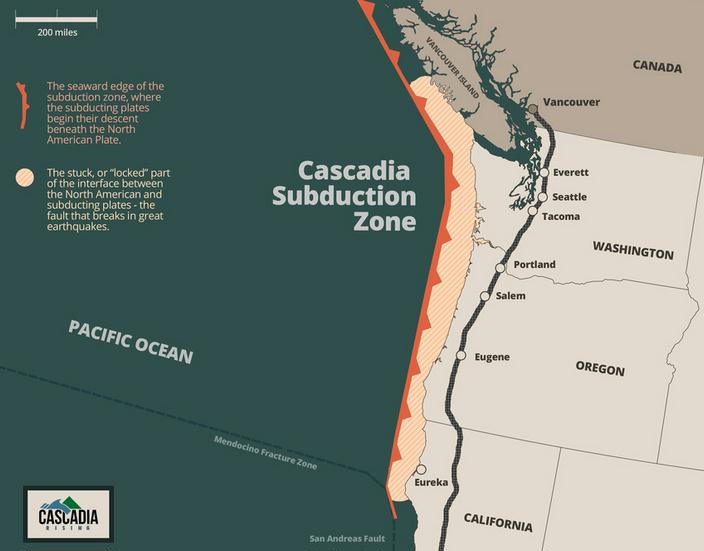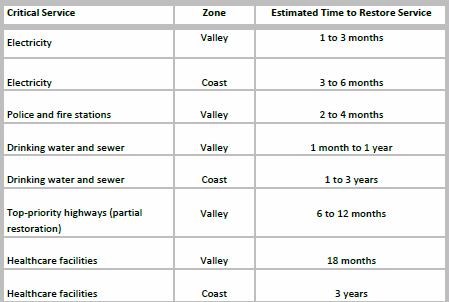[ Would a several hundred billion dollar earthquake shake the global financial system enough to bring on a world-wide depression? It’s not just the costs of repair, but the indirect costs, such as destruction of the Ports of Seattle and Portland, and the many companies in Oregon and Washington (especially Seattle) that are important in global supply chains.
According to the Oregon Resilience Plan, “The interruption of normal economic activity could generate such huge costs that the region may never fully recover”.
And if this happens on the downside of oil production after global peak oil occurs, the energy available to rebuild may be difficult to find.
Alice Friedemann www.energyskeptic.com author of “When Trucks Stop Running: Energy and the Future of Transportation, 2015, Springer]
The Cascadian subduction zone earthquake is capable of a 9.0 Richter scale earthquake that would rip the continent up from northern California and into Canada (as shown above), resulting in a second horrifying disaster: an 800 mile-long tsunami that will smash into much of the Northwest coast 15 minutes later, and hours later again in Japan.
Over the past 10,000 years, there have been 41 such earthquakes, on average every 243 years, and it’s been 316 years since the last one (though they have occurred as often as every 200 years and as far apart as 1,000 years).
Kenneth Murphy, who directs the FEMA’s area responsible for Oregon, Washington, Idaho, and Alaska, says, “Our operating assumption is that everything west of Interstate 5 will be toast.
Here are some of the grim stats (FEMA), which assumes an earthquake at 9:41 AM on February 6th
- 13,000 will die (more if it happens on a warm summer day and thousands are on the beaches when the tsunami strikes)
- 27,000 injured
- 7 million people will be affected
- 1,000,000 in need of a shelter
- 2,500,000 in need of food and water
- The Oregon Resilience Plan states that “Direct damages may reach into the hundreds of billions of dollars in Oregon” (so the FEMA estimate of $49 billion losses in Washington and $32 billion in Oregon seem a bit low)
- Thousands of landslides, 30,000 in Seattle alone
- Liquefied soil collapses, affecting 6 miles of Portland where 90% of Oregon’s oil and natural gas flows, and much other critical infrastructure. Fifteen percent of Seattle will be affected.
- Over a million structures will collapse or be harmed, since over 75% of structures weren’t designed for a 9.1 earthquake
- Collapse of half of all highway bridges, two-thirds of railways, and so on.
What follows is from the 2013: Oregon Resilience Plan. Reducing Risk and Improving Recovery for the Next Cascadia Earthquake and Tsunami Report to the 77th Legislative Assembly from Oregon Seismic Safety Policy Advisory Commission. 341 pages.
Recovery time in Oregon
Utilities cannot be repaired if roads and bridges are impassable. Likewise, the communication infrastructure is interdependent with the transportation network. If communications systems are down, repair crews have no way of knowing where they are needed most.
Before a business can reopen following a Cascadia earthquake, the building it occupies has to be certified to be structurally safe, it has to be served by municipal and private utilities, and the communications infrastructure must be operating. A business that cannot reopen within a month of a major earthquake or other disaster resulting in extended service disruption will likely never reopen at its previous location (see Figure 2.10). Potable water, sewage systems, heating (natural gas or electric), and ventilating systems must be operable before workers can reoccupy a business. To a lesser extent, but nevertheless important in our ever more technologically oriented business environment, the communications infrastructure must be re-established before businesses can be re-established.
The emergency plan
It is almost certain that a Cascadia subduction zone earthquake will cause all private and public utilities to fail; this means there will be no municipal water or sewer service, no electricity, no telephone, and no television, radio, or internet. Without power, local grocery stores will be unable to keep frozen foods frozen or fresh meats and dairy cold enough to prevent spoiling. It is likely that most of the food in the grocery stores will be distributed (as opposed to sold) to the public because the store’s registers will not work without power and there would be no sense in letting frozen foods, meats, and dairy products spoil in the store. Because stores are routinely resupplied several times each week, the amount of food actually held in an individual store is probably no more than what is required to supply the surrounding neighborhood for a few days. In particular, fresh fruits, vegetables, and dairy products are typically replenished several times a week, so the quantities kept in stock are not large. With supplies already limited, a related concern is that people will hoard food out of fear that stores will run out completely. In the near term, such hoarding will exacerbate the erosion of the food supply.
Once the food supply at local grocery stores is exhausted, the government will have to set up food distribution centers to support the population until local grocery stores regain electrical power and municipal services and can be resupplied. That resupply activity also requires the transportation and distribution network to be functioning (see Figure 2.8). Transportation lifelines have to be open for trucks to deliver the food, and truckers have to know where the lifeline routes are located and which bridges have been seismically braced and are safe to use following the earthquake. The transportation of supplies by truck is further dependent on the fuel supply. Currently, Oregon’s liquid fuel supply is severely constrained. The main liquid fuel depot in the Portland Metro area is a “tank farm” located in Northwest Portland, adjacent to Highway 30, built on soils that are highly susceptible to liquefaction.
the resupply of food is dependent on a functioning banking system. All commercial transactions at grocery stores involve a debit or credit card issued from a bank (or the Oregon Trail cards issued by the state), a check (which is nearly always scanned to prevent fraud), or cash. Even after electrical power is restored and communications between stores and banks reestablished, the banks themselves have to be functioning in order to assure the stores that transactions will result in actual payment (see Figure 2.9). Even cash purchases will require banks to have cash to distribute, and the banks’ own information systems have to be functioning in order for them to distribute cash to their customers via bank teller or ATM network.
References
FEMA. Cascadia Subduction Zone Earthquakes: A magnitude 9.0 Earthquake scenario. 2013. Cascadia Region Earthquake Workgroup.
Schulz, K. July 20, 2015. The Really Big One. An earthquake will destroy a sizable portion of the coastal Northwest. The question is when. The New Yorker.



One Response to Cascadia subduction zone 9.0 earthquake will cost hundreds of billions of dollars and many lives